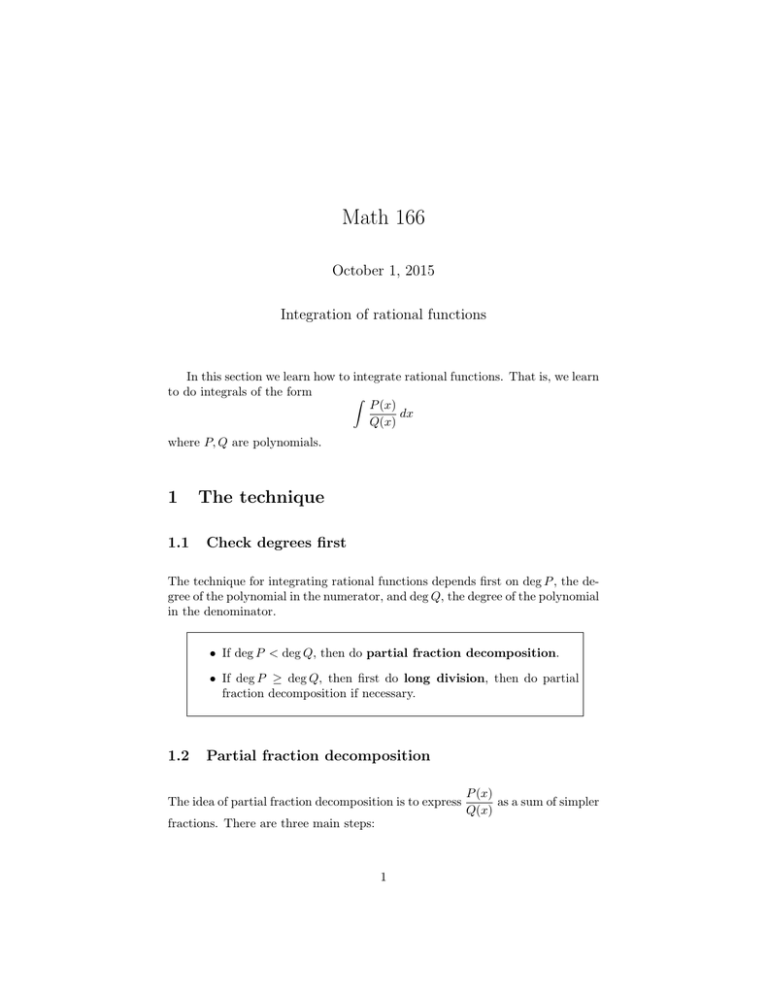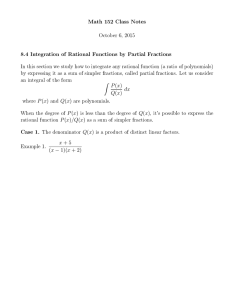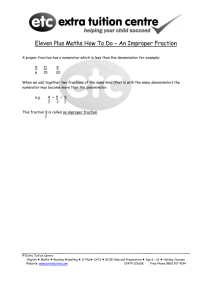Math 166 October 1, 2015 Integration of rational functions
advertisement

Math 166 October 1, 2015 Integration of rational functions In this section we learn how to integrate rational functions. That is, we learn to do integrals of the form Z P (x) dx Q(x) where P, Q are polynomials. 1 1.1 The technique Check degrees first The technique for integrating rational functions depends first on deg P , the degree of the polynomial in the numerator, and deg Q, the degree of the polynomial in the denominator. • If deg P < deg Q, then do partial fraction decomposition. • If deg P ≥ deg Q, then first do long division, then do partial fraction decomposition if necessary. 1.2 Partial fraction decomposition The idea of partial fraction decomposition is to express fractions. There are three main steps: 1 P (x) as a sum of simpler Q(x) • Factor Q(x) completely into irreducible linear and quadratic terms. • Set up the decomposition with unknown coefficients. • Solve for the unknown coefficients using tricks like the cover up method, plugging in your favorite number, or clearing the denominator and grouping like terms. 1.2.1 Set up • If (x − a) is a linear factor of Q(x) and (x − a)m is the highest power that divides Q(x), then assign to this factor the sum A1 A2 Am + + ··· + . x − a (x − a)2 (x − a)m Do this for each distinct linear factor. • If (x2 + bx + c) is an irreducible quadratic factor of Q(x) and (x2 + bx + c)n is the highest power that divides Q(x), then assign to this factor the sum B1 x + C1 B2 x + C2 Bn x + Cn + + ··· + 2 . x2 + bx + c (x2 + bx + c)2 (x + bx + c)n Do this for each distinct irreducible quadratic factor. 1.2.2 Solve • For distinct linear factors use the cover up method. • For repeated linear factors first use cover up method, then pick your favorite number. • For irreducible quadratic factors clear the denominator, group terms, and compare coefficients on both sides of the equation. 2 1.3 Integrate Once you’ve finished the algebraic work of partial fraction decomposition and/or long division, all that’s left is to integrate the sum of simpler terms. You may need to do u-substitution or trigonometric substitution. 2 Problems Problem 1 Z x+3 dx 2x3 − 8x We do partial fraction decomposition: (1) Factor x+3 x+3 x+3 = = 2x3 − 8x 2x(x2 − 4) 2x(x − 2)(x + 2) (2) Set up A B C x+3 = + + 2x(x − 2)(x + 2) 2x x − 2 x + 2 (3) Solve: Look at the left hand side of the equation above and (a) cover up 2x and plug in x = 0: this gives A = −3/4 (b) cover up x − 2 and plug in x = 2: this gives B = 5/16 (c) cover up x + 2 and plug in x = −2: this gives C = 1/16. Therefore Z −3/4 5/16 1/16 + + dx 2x x−2 x+2 3 5 1 = − ln |x| + ln |x − 2| + ln |x + 2| + C 8 16 16 x+3 dx = 2x3 − 8x Problem 2 Z Z x2 x dx + 2x + 1 We do partial fraction decomposition: 3 (1) Factor x2 x x = + 2x + 1 (x + 1)2 (2) Set up x A B = + 2 (x + 1) x + 1 (x + 1)2 (3) Solve: multiply both sides of the above equation by the denominator of the right hand side and observe that x = A(x + 1) + B. Next we consider this new equation and plug in (a) x = −1 and get B = −1. (b) x = 0 and get A = 1. Therefore Z Problem 3 1 −1 + dx x + 1 (x + 1)2 1 +C = ln |x + 1| + x+1 x dx = 2 x + 2x + 1 Z Z x2 + 2x + 1 dx (x2 + 1)2 We do partial fraction decomposition: (1) Factoring is already done for us. (2) Set up Ax + B Cx + D x2 + 2x + 1 = 2 + 2 2 2 (x + 1) x +1 (x + 1)2 (3) Solve: multiply both sides of the above equation by the denominator of the right hand side, multiply out, and group terms: x2 + 2x + 1 = (Ax + B)(x2 + 1) + Cx + D = Ax3 + Bx2 + Ax + B + Cx + D = Ax3 + Bx2 + (A + C)x + (B + D). Next we compare coefficients on both sides of the above equation. 4 (a) Coefficient on x3 on the right hand side is 0 which means A = 0 (b) Coefficient on x2 on the right hand side is 1 which means B = 1 (c) Coefficient on x on the right hand side is 2 which means C = 2 (d) Constant term on the right hand side is 1 which means D = 0 Therefore Z x2 + 2x + 1 dx = (x2 + 1)2 Z 1 2x + x2 + 1 (x2 + 1)2 1 = tan−1 x − 2 + C. x +1 Problem 4 Z dx 1 dx (x2 − 1)2 We do partial fraction decomposition: (1) Factor 1 1 = (x2 − 1)2 (x − 1)2 (x + 1)2 (2) Set up 1 (x − 1)2 (x + 1)2 = A B C D + + + 2 x − 1 (x − 1) x + 1 (x + 1)2 (3) Solve: multiply both sides of the above equation by the denominator of the right hand side: 1 = A(x − 1)(x + 1)2 + B(x + 1)2 + C(x + 1)(x − 1)2 + D(x − 1)2 . Next we consider this new equation and plug in (a) x = 1 ⇒ B = 1/4 (b) x = −1 ⇒ D = 1/4 (c) x = 0 ⇒ 1 = A + 1/4 + C + 1/4 ⇒ A + C = 1/2 (d) x = 2 ⇒ 1 = 9A + 9/4 + 3C + 1/4 ⇒ 9A + 3C = −3/2 The equation in (c) gives A = 1/2 − C which, plugging into (d), gives 9(1/2 − C) + 3C = −3/2 ⇒ which implies A = −1/2. 5 −6C = −6 ⇒C=1 Therefore Z Z 1 1 −1/2 1/4 1/4 dx = + dx + + (x2 − 1)2 x − 1 (x − 1)2 x + 1 (x + 1)2 1 1 1 = − ln |x − 1| − + ln |x + 1| − +C 2 4(x − 1) 4(x + 1) Problem 5 Z x4 + x2 − 1 dx x3 + x We start with long division: x x3 + x))x4 + x2 + 1 x4 + x2 5 1 which gives that 1 x4 + x2 − 1 =x+ 3 x3 + x x +x Now we do partial fraction decomposition for the term 1 : x3 + x (1) Factor 1 1 = x3 + x x(x2 + 1) (2) Set up 1 A Bx + C = + 2 x(x2 + 1) x x +1 (3) Solve: multiply both sides of the above equation by the denominator of the right hand side: 1 = A(x2 + 1) + (Bx + C)x (a) Plug in x = 0 and get A = 1. (b) Rewrite the equation as 1 = x2 + 1 + Bx2 + Cx = (B + 1)x2 + Cx + 1. Therefore B = −1 and C = 0. 6 Therefore Z x4 + x2 − 1 dx = x3 + x Z −x 1 dx x+ + 2 x x +1 1 1 = x2 + ln |x| − ln |x2 + 1| + C. 2 2 7





